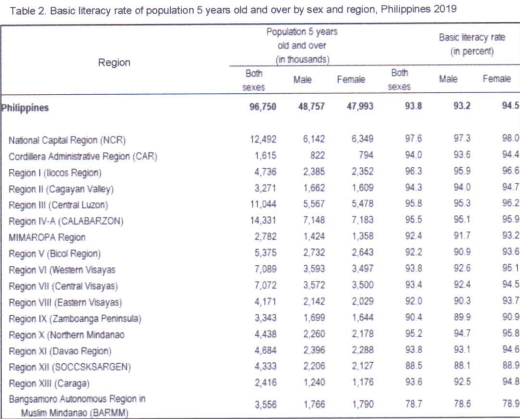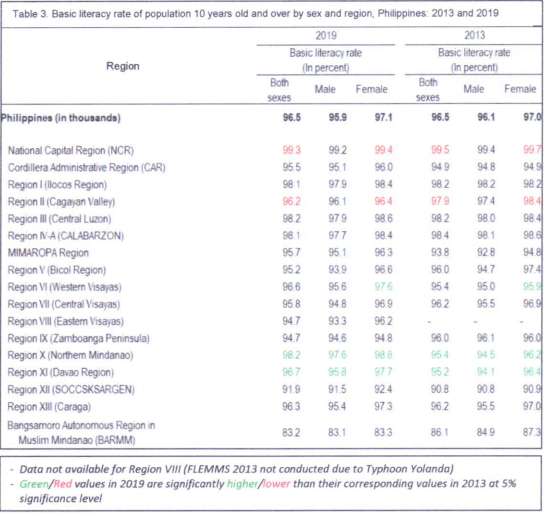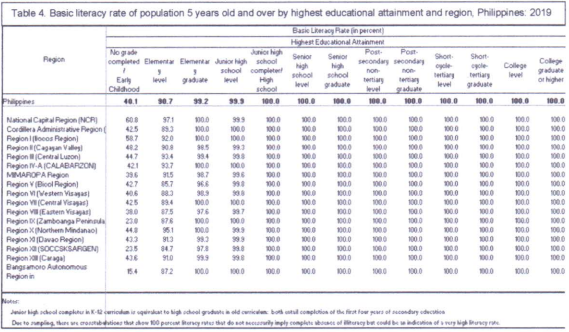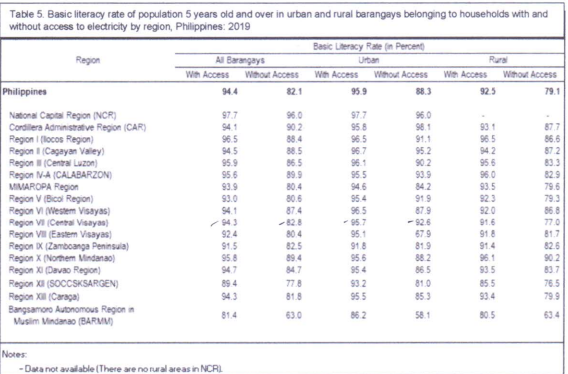The Functional Literacy, Education and Mass Media Survey (FLEMMS) is a nationwide household-based survey and one of the designated statistical activities of the Philippine Statistics Authority (PSA) by virtue of Executive Order No. 352. The 2019 FLEMMS is the sixth in the series of literacy surveys in the country starting in 1989. Prior to this survey round, FLEMMS was conducted in 2013.
Ninety-three (93) of every 100 Filipinos in Central Visayas aged five (5) years old and over are basic literate in 2019, according to the results of the 2019 FLEMMS. Females posted higher basic literacy of 94.5% compared to males with 92.4%. Across regions, the National Capital Region (NCR) registered the highest basic literacy rate at 97.6 percent for both sexes, while the Bangsamoro Autonomous Region in Muslim Mindanao (BARMM) had the lowest at 78.7 percent (Table 1 and Table 2).


Meanwhile for population 10 years old and over in Central Visayas it registered a 95.8 percent basic literacy rate in 2019 lower than the 96.2 percent in 2013 (Figure 1). In addition, the basic literacy rate among females of 96.9% remained higher than among males in 2019 and 2013 (Table 3).

Among Filipinos five (5) years old and over in Central Visayas, those who were at least junior high school completer in the K-12 curriculum, or equivalently high school graduate in the old curriculum, had 100.0 percent or a very high basic literacy rate, while those with no grade completed or at most received early childhood education had the lowest recorded basic literacy rate at 42.5 percent 1(Tables 4).

In Central Visayas, Filipinos aged five (5) years old and over who had access to electricity were reported to have higher basic literacy rate of 94.3% than those without access with 82.8%. Likewise, those living in urban areas, with or without access to electricity, posted higher basic literacy rate of 95.7% and 92.6%, respectively, compared with those in rural areas with 91.6% and 77.0%, respectively (Table 5).

TECHNICAL NOTES
2019 FUNCTIONAL LITERACY, EDUCATION AND MASS MEDIA SURVEY
I. Introduction
a. Background
The Functional Literacy, Education and Mass Media Survey (FLEMMS) is a household-based nationwide survey conducted every five (5) in accordance with the Designation of Statistical Activities that will Generate Critical Data for Decision-making of the Government and the Private Sector (Executive Order No. 352 of 1996). FLEMMS 2019 is the sixth in the series of literacy surveys in the country starting in 1989. Prior to this survey round, FLEMMS was conducted in 2013.
b. Objectives
FLEMMS provides a quantitative framework that will serve as basis in the formulation of policies and programs on the improvement of literacy and education status of the population. It has the following specific objectives:
1. To estimate the proportion of the population 10 years old and over who are basically literate;
2. To estimate the proportion of the population 10 to 64 years old who are functionally literate and to determine their socio-economic characteristics;
3. To determine the educational skill qualifications of the population in terms of formal schooling; and,
4. To determine the mass media exposure of the population.
c. Scope and Coverage
With regions as domain, survey operations for FLEMMS 2019 ran from November to December 2019, and covered 41,686 eligible sample households and 119,807 individuals/household members 10 to 64 years old.
d. Questionnaires/Forms:
The survey utilized two questionnaires:
- FLEMMS Form 1, a household questionnaire, administered through face-to-face interview, was used to gather information about basic literacy, education, and employment of the population; and,
- FLEMMS Form 2, a self-administered questionnaire, was used to collect information on functional literacy and mass media exposure of population 10 to 64 years old. The basic reading, writing and numeracy skill was measured by a standardized assessment instrument/scoring system developed in 1985 by the National Statistics Office in cooperation with the then Department of Education, Culture and Sports. The instrument was revised and, beginning FLEMMS 1989, FLEMMS Form 2 was implemented. In later rounds of the survey, basic reading comprehension skill was also measured in FLEMMS Form 2
e. Changes from FLEMMS 2013
The FLEMMS, as in any survey, adopts recent developments in statistical methodology/processes and in the education system. The table below summarizes the comparison between FLEMMS 2019 and FLEMMS 2013:
II. Concepts and Definitions
Basic literacy is the ability of a person to read and write with understanding of a simple message in any language or dialect. The basic literacy status of an individual was determined based on the respondent’s answer to the question “Can _____ read and write a simple message in any language or dialect?” in FLEMMS Form 1.
Functional literacy is a significantly higher level of literacy which includes not only reading and writing skills but also numeracy skills. The skills must be sufficient advanced to enable the individual to participate fully and efficiently in activities commonly occurring in his/her life situation that require a reasonable capability of communicating by written language. Persons who at least graduated from high school under the old curriculum for basic education, or at least junior high school completer under the K-12 curriculum are automatically classified as functionally literate.
Levels of literacy identifies the range of skills and competencies of an individual. Specifically,
Youth:
Defined by the United Nations, for statistical purposes, as persons between the ages of 15 and 24 years, without prejudice to other definitions by Member States (https://www.un.org/en/sections/issues-depth/youth-0/). This definition is also adopted by the United Nations Educational, Scientific and Cultural Organization (UNESCO) and the International Labor Organization (ILO). (https://www.un.org/esa/socdev/dcouments/youth/fact-sheets/youth.definition.pdf)
As defined in Section 2, paragraph 2 of Republic Act 8044 (The Youth in Nation-Building Act), is the critical period in a person’s growth and development from the onset of adolescence towards the peak of mature, self-reliant, and responsible adulthood comprising the considerable sector of the population from the age of 15 to 30 years.
Children are those persons under the age of fourteen in consideration of the statistical definition of youth.
Mass Media refers to technology that is intended to reach a mass audience. It is the primary means of communication used to reach the vast majority of the general public. The most common platforms for mass media are newspapers, magazines, radio, television, and the internet.
Open distance learning is a system of learning which combines the methodology of distance education with the concepts of open learning and flexible learning.
- Distance education is a mode of learning in which students and teachers are physically separated from each other. The personalized and distributed way of learning makes it easier for learners to study at their own pace using various media such as the internet, radio, and television.
- Open learning is an educational system which makes learning accessible to every individual with minimal restrictions. It emphasizes the flexibility of learning despite barriers to age, geographical location, time constraints and economic situation.
Government information refers to any records, documents, papers, reports, letters, contracts, minutes and transcripts of official meetings, maps, books, photographs, data, research materials, films, sound and video recordings, magnetic or other tapes, electronic data, computer-stored data, or any other like or similar data or materials recorded, stored, or archived in whatever format, whether offline or online, which are made, received, or kept in or under the control and custody of any government office pursuant to law, executive order, and rules and regulations or in connection with the performance or transaction of official business by any government office (Executive Order No. 02, series of 2016).
This does not include requests for information on government services which cover processes or transactions involving applications for any privilege, right, reward, license, clearance, permit or authorization, concession, or for any modification, renewal or extension of the enumerated applications or requests which are acted upon in the ordinary course of business of the agency or office concerned. Examples include requests for information on the processes in getting birth and marriage certificates, business permits, barangay clearances, passports, pension and retirement benefits, etc. (Republic Act No. 11032 Ease of Doing Business and Efficient Government Service Delivery Act of 2018).
III. Sampling Design and Estimation Methodology
The FLEMMS 2019, being a household-based survey, used the 2013 Master Sample (MS) design of which 4 replicates equivalent to a total of 42,768 Secondary sampling Units (SSUs) or sample housing units were included as samples. Using a two-stage cluster sampling design, EAs/barangays were selected at the initial sampling stage as the primary sampling units (PSUs), while the housing units within the selected PSUs are selected as the secondary sampling units (SSUs). Generally, all households within the sample housing unit are also considered as sample households. However, for housing unit with more than three (3) households, a maximum of three (3) sample households were randomly selected.
Sampling Frame
The 2013 MS sampling frame was constructed based on the results of the 2015 Population Census. The EA Reference File (EARF) of the 2015 Census of Population was used as the PSU frame while the 2015 list of households for each of the PSUs were used as the SSU frame. Sampling Domain To provide subnational or provincial level statistics with precise estimates, the 2013 MS has 117 major domains as follows: 81 provinces (including the newly created province Davao Occidental); 33 highly urbanized cities (including 16 cities in the National Capital Region); and 3 other areas (Pateros, Isabela City, and Cotabato City). Primary Sampling Units In the 2013 Master Sample Design, each sampling domain (i.e., province/HUC) is divided into exhaustive and non-overlapping area segments known as Primary Sampling Units (PSUs) with about 100 to 400 households. Thus, a PSU can be a barangay/Enumeration Area (EA) or a portion of a large barangay, or two or more adjacent small barangays/EAs.
The PSUs are then ordered according to the following: (1) North-South/West-East Geographic location; (2) Decreasing Proportion of HHs with Overseas Worker; and (3) Decreasing wealth Index.
Replicates
For the FLEMMS 2019, four replicates are used in all 117 sampling domains. A replicate is composed of ordered list of PSUs. Most of the provinces, that is, 75 out of 81, has six PSUs per replicate while in HUCs, eight PSUs form a replicate. Small domains such as Guimaras, Siquijor, Camiguin, Apayao, and Dinagat Islands had three PSUs per replicate.
Sample Allocation Scheme
For FLEMMS 2019, a total of four sample replicates were allotted. However, the total number of sample SSUs was allotted proportionately to the measure of size of the PSU. Thus, a PSU with only 100 HHs had less number of sample HHs than PSUs with 400 HHs but, on the average, there were 12 sample HHs allotted for each PSU in Highly Urbanized Cities (HUCs) and an average of 16 sample HHs for every PSU in the province.
A total national sample of 42,768 sample HHs was allotted for the 2019 FLEMMS.
Base Weight Computation
The base weight is computed as the inverse of selection probability
Base Weight Adjustment
The base weight adjusted for unit non-response and was further calibrated to conform to the known or projected population count. For 2019 FLEMMS, the projected population count used was November 2019.
For unit non-response adjustment (within domain p), the adjustment was computed as:
Estimation of Sampling Error
Sampling error is usually measured in terms of the standard error for a particular statistic (mean, percentage, etc.), which is the square root of the variance.
If the sample had been selected as a simple random sample, it would have been possible to use straightforward formulas for calculating sampling errors. However, the FLEMMS 2019 is the result of a multi-stage design, and it was necessary to use more complex formulas.
Sampling errors are computed using statistical programs. These statistical programs use the Taylor linearization method to estimate variances for survey estimates that are means, proportions, or ratios.
The Taylor linearization method treats any percentage or average as a ratio estimate, r=y/x, where y represents the total sample value for variable y, and x represents the total number of cases in the group or subgroup under consideration. The variance of r is Weighted Region Totals Page 11 of 12 computed using the formula given below, with the standard error being the square root of the variance:
In FLEMMS 2019, the 117 province/HUC domains are also treated as natural stratification while the primary sampling units (PSUs) are treated as clusters.
Data Checking, Coding and Filtering Prior to Estimation of Proportions
Data checking starts in the provinces where field enumeration is undertaken, based on the set of consistency checks provided in the FLEMMS 2019 Data processing Manual. The same set of specifications is embedded in the machine data processing system after the data are encoded in the regions, and submitted to the Central Office as part of checking on the submissions from the field offices.
During data analysis, another layer of checking/data filtering is done through crosstabulation of related variables/characteristics, based on unweighted data. Cases with observed inconsistencies are returned to the field offices for verification. Verified/vetted information, including the correction of typographical errors/miscoded entries (particularly those involving multiple-digit codes) are reflected in the individual records. The updated datafile is then used to come up with the final estimated counts, and proportions.
IV. Dissemination of Results
FLEMMS 2019 results shall be disseminated online at the PSA website at www.psa.gov.ph, releasing three (3) Press Releases, as follows:
• Press Release 1: Basic Literacy
• Press Release 2: Functional Literacy
• Press Release 3: Mass Media
A final report shall likewise be released after the press releases are posted.
V. Citation
Philippine Statistics Authority. (26 October 2020). Technical Notes on the 2019 Functional Literacy, Education and Mass Media Survey (FLEMMS) https://psa.gov.ph/technicalnotes/flemms-2019
Approved by:
(SGD.) ARIEL E. FLORENDO
Regional Director

